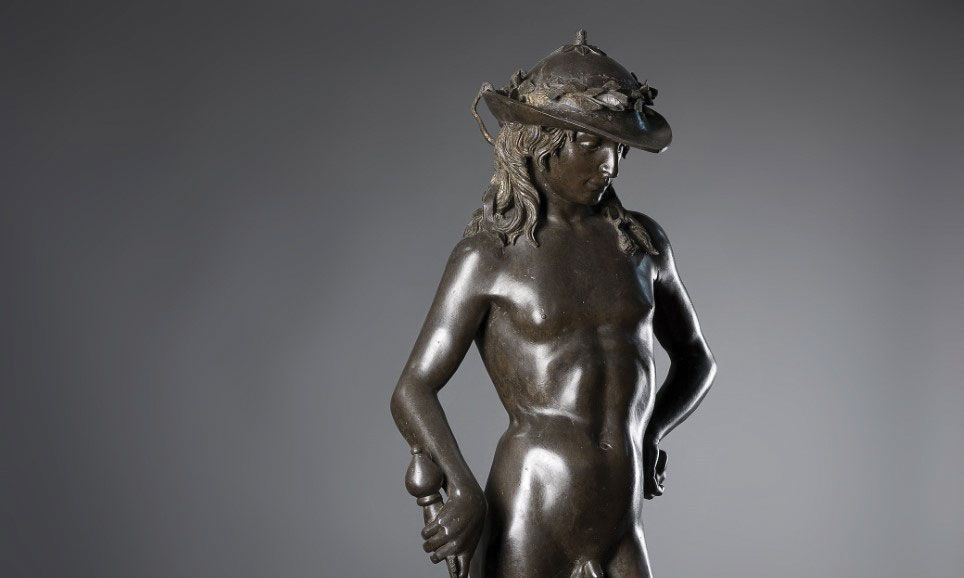Donatello’s bronze David (around 1435-1440) from the Museo Nazionale del Bargello will be a highlight of the show Courtesy Museo Nazionale del Bargello, Florence
In his own time, the 15th-century Florentine sculptor Donatello was regarded as “the master of masters”, an artist so technically skilled in a range of materials, so expert at creating the illusion of volumetric forms with the most subtle carving, so deft at representing the full gamut of human emotion and so capable of understanding and incorporating the artistic techniques of antiquity in his own work that “his innovations held sway with artists for 150 years afterwards”, says Arturo Galansino, the director of Palazzo Strozzi in Florence. “Michelangelo, Raphael, Leonardo—they all looked to Donatello.”
Despite this, there has been no major exhibition devoted to the sculptor’s work for nearly 40 years. “The Renaissance has been a bit out of fashion,” Galansino says. That, at least, is set to change in March when a sweeping survey of Donatello’s work opens in Florence at Palazzo Strozzi and at the nearby Museo Nazionale del Bargello, which houses the most important collection of works by the sculptor including David (around 1440), the first free-standing nude male sculpture made since antiquity.
Smaller incarnations of the show will be seen at the Gemäldegalerie in Berlin in September and the Victoria and Albert Museum in London in 2023. “The shows in Berlin and London will present their own view of the artist, parallel to ours. Not all of the experts working on these exhibitions agree on everything, for example, on the chronology of his works. This is what makes this project exciting; there is still so much to discover,” Galansino says.
In Florence there will be around 130 works on display, including bas reliefs made by Donatello for the Baptistery in Siena and for the Basilica of St Anthony in Padua, as well as smaller devotional statuettes, painted wooden crucifixes and reliquaries. Loans will also come from the Detroit Institute of Art, the Metropolitan Museum of Art in New York, the Museum of Fine Art Boston, the Louvre in Paris and the Kunsthistorisches Museum in Vienna, among many others. Crucially, the Florentine survey will also include numerous paintings. “We will show how Donatello influenced his contemporaries—Brunelleschi, Masaccio, Andrea Mantegna, Giovanni Bellini—but also how his artistic vision reigned supreme until the arrival of Caravaggio. This has never been done before,” Galansino says.
For Francesco Caglioti, who curated the exhibition in Florence, Donatello’s work is urgently in need of reassessment. “He is a colossal artist, more important than Giotto, Raphael or Caravaggio because those three revolutionised the traditions of their time. Donatello broke with tradition completely, taking inspiration from the art of antiquity and the Middle Ages and mixing all those elements with his own vision to create an entirely new language for art.”
This marble Madonna and Child, 1420-25 shows not just Donatello’s skill at sculpting in bas-relief but also his keen interest in depicting the emotions of his subjects. “For the first time in the history of art, Donatello depicts both mother and child with their faces turned towards one another and away from viewers; they are touching foreheads, sharing a profoundly intimate moment which every mother has experienced. Donatello was exceptionally talented in translating nature into art,” says Francesco Caglioti, curator of the Florence exhibition © Antje Voigt/SMB Skulpturensammlung
“He understood better than any of his contemporaries that sculpture is an inert art form. He tried every technique he could think of to animate it. Think of his bronze sculpture David. Today it is displayed just above eye level, which creates the impression of a sheepish boy staring at his own feet,” Caglioti explains. But the work was made to stand atop a tall column and, seen from below, David’s gaze is “transformed into the triumphant attitude of a hero gazing down at the Florentine public. I never liked this sculpture very much until I understood that its distortions were deliberate, until I looked at it the way it was intended to be seen, from below.”
Caglioti hopes his show will be able to display David as Donatello wanted him to be seen, on the top of a column. Another major challenge in shifting public perceptions of the artist is that many of his sculptures have been photographed from the wrong angle and so appear completely distorted in art history text books, says Caglioti. For example, his celebrated equestrian statue of a mercenary captain, Gattamelata (1453), in Padua, is always reproduced from the side. But Donatello made it to be seen from the front. All of his work needs to be re-photographed and rediscovered.”
• Donatello: the Renaissance, Palazzo Strozzi and Museo del Bargello, Florence, 19 March-31 July; Gemäldegalerie, Berlin, 2 September-8 January 2023

